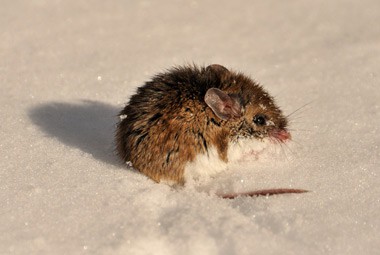
Deer mice are a species of rodent that are found throughout much of North America. They are not quite as common of a pest as the house mouse, but still will invade structures, cause damages, and introduce diseases to humans; including the very dangerous hantavirus.
| Pest Identification | |
|---|---|
| Recognition | Deer mice are named so because of their color pattern resembling that of a deer. They have a brown body with a white underbelly and feet. They also are very fast runners and agile jumpers which gives them very “deer” like characteristics. Deer mice range in length from 5-8 inches including the tail. They have large dark eyes, ears, and a bicolored tail. |
| Biology | Deer mice reproduction depends on the amount of food available and the temperature outside. If they are living in a warm environment with plenty of food they may breed year-round. If the weather becomes cold and food becomes scarce they may take a break from breeding over the winter months. Deer mice begin breeding at only about six weeks of age, their gestation time is 24 days, and each female can produce up to eleven litters each year with about 2-9 young in each litter. The babies are weaned at 4 weeks of age and are ready to breed and increase the deer mouse population in another two weeks. Deer mice are carriers of the Hantavirus. This virus is located in their saliva, urine, feces. When humans inhale dust or other particles that contain the Hantavirus they can become infected with the disease. Hantavirus causes Hantavirus pulmonary syndrome (HPS); symptoms can include fever, headache, and serious and sometimes deadly respiratory problems. |
| Habits | Deer mice are commonly found living in forests, fields, and agricultural lands. They typically will only be found in homes and other buildings that are located next to those types of habitats. Deer mice are nocturnal and during the day they hide in their nesting areas, coming out overnight to feed. They typically feed on items including seeds, fruits, invertebrates, fungi, and nuts. In the fall when food is plentifully they gather and store food near their nests to consume over the winter months. If deer mice do find their way into a home or other building they typically live and nest in attics and behind wall voids. Inside of homes and businesses they can create a lot of damage by chewing through wires, pipes, drywall, insulation, and flooring; along with damaging personal items like clothing, furniture, books, and pictures. They also leave a trail of urine and feces throughout your home as they travel through it. |
| Prevention | Preventing deer mice from entering into your home includes removing the environments around your home that may attract them to it. Make sure that garbage cans have tight-fitting lids on them and that they and woodpiles and compost piles are kept a distance away from your home. You should also trim back trees, bushes and other landscaping from your house. It is important to seal cracks and crevices in foundations, place a tight-fitting cap on chimney’s, make sure vent covers are secure, and caulk gaps around windows and doors. Deer mice can fit through very small openings in order to enter into a building. |
| Professional | They best and most assured way to control deer mice in your home and on your property is with the help of our experts here at Rottler Pest & Lawn Solutions. Our professional technicians can help to control deer mice in your home by thoroughly inspecting your property and determining where the mice may be entering. We will then either recommend exclusion techniques or perform the exclusion steps for you. An elimination and exclusion program can be developed using tamper-resistant bait stations inside and outside the home in areas where they are most likely to inhabit- attics, behind appliances, under sinks, and outdoors along foundation walls and under decks. Snap traps and glue boards may also be used to help eliminate an infestation. Due to the risk of exposure to Hantavirus, when removing or cleaning up after a deer mouse infestation, we recommend using a respirator, disinfecting and dampen the areas to help control dust particles in the air; because these precautions are necessary, professional treatments are recommended. |

